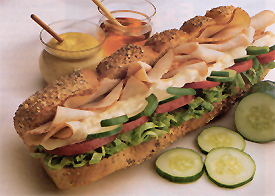Restaurant Lunch Spending to Bounce Back in 2011
 NEW YORK -- Following two years of recession-related declines, U.S. consumer spending on lunch served in restaurants is forecast to rebound 2 percent in 2011 to reach $114 billion, according to the newly released "Lunch Trends in the U.S. Foodservice Market" report by Packaged Facts.
NEW YORK -- Following two years of recession-related declines, U.S. consumer spending on lunch served in restaurants is forecast to rebound 2 percent in 2011 to reach $114 billion, according to the newly released "Lunch Trends in the U.S. Foodservice Market" report by Packaged Facts.
After rising to $119 billion in 2008, lunch daypart sales declined 4 percent in 2009, and sales are estimated to fall another 3 percent in 2010 to $112 billion, the report stated.
"This has been a very tough climate for lunch foodservice and its counterparts and that won't change overnight, although change is coming," said Don Montuori, publisher of Packaged Facts. "Growth in the lunch daypart still faces a few near-term challenges including the impact of unemployment on work-driven restaurant routines; bargain-minded consumers who weigh the cost of a bagged lunch against the indulgence of eating out; and an industry environment in which players are chasing foot traffic at the expense of guest check through the extreme push of value meal deals."
Ironically, by pushing the envelope with $1 deals, fast-food operators are enabling a pool of "extreme affordability" customers hooked on products that have indeed undermined guest check averages, yet have also helped sustain the industry, according to the report.
Respondents to Packaged Facts' proprietary survey revealed that interest in lunchtime meals priced under $5 and under $10 is stable across household income brackets, suggesting price sensitivity among a large segment of diners regardless of their personal wages. Respondents aged 18-24 are 60 percent more likely than average to choose a restaurant because it offers meals for under $3.
The ubiquitous limited-time offer -- with its allure to attract new visits and test longer-term menu strategies -- and the addition of bundling components could allow restaurants to build up guest check sizes without sacrificing foot traffic, Packaged Facts reported. Notable examples of this include Taco Bell's $2 Meal Deal, which by offering three items for $2 is intended as a twist on the more common 1:1 ratio of items per dollar, the researcher notes.
Additionally, strategies by the likes of Denny's and Bob Evan's to place everyday value for quality food at the forefront of their branding initiatives makes a great deal of sense in the family restaurant sector, where value for the money has always been a selling point.
Ingredients are almost as important as price for many consumers when dining out, and food operators confirm guests' growing interest in better-for-you choices. Customers are seeking foods offering positive health benefits such as fiber and whole grains, and menu items featuring more vegetables or fruit and less meat. Packaged Facts' research suggests that students are more likely to be influenced by healthful lunch decisions, while both men and women are likely to choose a restaurant that offers smaller portion sizes to reduce cost and control calories.
The "Lunch Trends in the U.S. Foodservice Market" report also provides insight and analysis on recession-driven changes in the restaurant industry, with a focus on related consumer attitudes and behaviors shaping the industry today and positioning the industry for tomorrow.
Packaged Facts, a division of MarketResearch.com, publishes market intelligence on a wide range of consumer market topics, including consumer goods and retailing, foods and beverages, demographics, pet products and services, and financial products.

